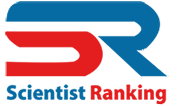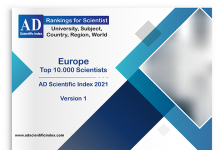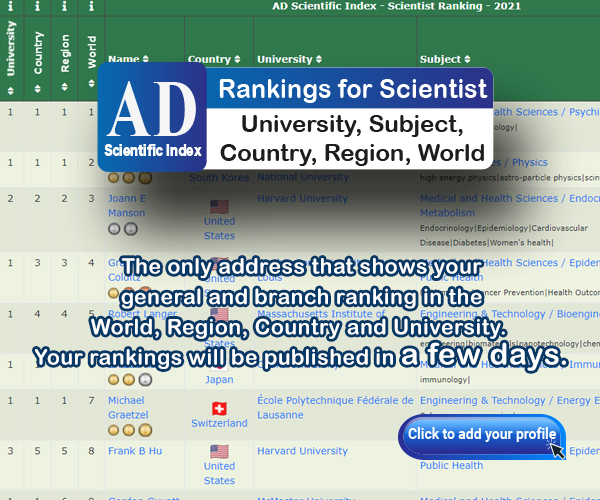Why is the “AD Scientific Index” needed?
The “AD Scientific Index” is the first and only study that shows the total and
the last five-year productivity coefficients of scientists based on h-index and i10
index scores and citations in Google Scholar. Furthermore, the index provides the
ranking and assessment of scientists in academic subjects and branches and in
13,600 universities, 206 countries, regions, and the world. In other words, the “AD
Scientific Index” provides both the ranking and analysis results.
“AD Scientific Index” (Alper-Doger Scientific Index):
This new index has been developed by Prof. Dr. Murat ALPER (MD) and
Associate Prof. Dr. Cihan DÖĞER (MD) by using the total and last 5 years’ values of
the i10 index, h-index, and citation scores in Google Scholar. In addition, the ratio of
the last 5 years’ value to the total value of the abovementioned indexes is used.
Using a total of nine parameters, the “AD Scientific Index” shows the ranking of an
individual scientist by 12 subjects (Agriculture & Forestry, Arts, Design and
Architecture, Business & Management, Economics & Econometrics, Education,
Engineering & Technology, History, Philosophy, Theology, Law / Law and Legal
Studies, Medical and Health Sciences, Natural Sciences, Social Sciences, and
Others), 256 branches, 13,600 institutions of employment, 206 countries, 11 regions
(Africa, Asia, Europe, North America, South America, Oceania, Arab Leageu, EECA,
BRICS, Latin America, and COMESA), and in the world. Thus, scientists can obtain
their academic rankings and monitor developments in the ranking over time.
Data Collection and Standardization:
Collecting data manually based on the ranking from Google Scholar, the
profiles with up to 300 citations and verified addresses or the profiles that build
confidence for their accuracy are listed primarily. Thus, it is aimed to standardize the
names, institutions, and branches as much as possible. Non-standardized data
including wide ranges of variations in the information and the use of abbreviations
and a variety of languages have caused difficulties. Performing data mining and
scrutinizing the acquired information, many profiles were excluded from the index.
Furthermore, some of the profiles were excluded during the regular examination of
the data onward. Data cleaning requires a regular process in place to be conducted
meticulously. We welcome your contributions in data cleaning and ensuring accuracy.
Determining the subjects/departments, to which scientific fields would belong,
may seem easy in some branches and in a variety of countries. However, it may
create considerable confusion in some other countries, regions, and schools. We
would like to emphasize that the following fields including Engineering, Natural and
Environmental Sciences, Biology, and Biochemistry, Material Science, Chemistry, and
Social Sciences may exist in quite variable spectrums in different countries.
Therefore, we would like to stress that the standardization of subjects and branches
has not been easy. To perform standardizations, we accepted the official names of
the institutions and academic branches as accurate in the way that they were
specified on the university website. We have developed this strategy in order to
standardize this complex situation at least partially.
Studies that influence the order of ranking because of a high number
of citations received, in a manner similar to CERN:
We started a procedure to add an asterisk as “*” at the end of the names of
the authors when a scientific paper of interest included many authors such as CERN,
ATLAS, ALICE, CMS, Statistical Data, Guideline, Updates etc. scientific papers. We
think that new criteria will be defined to be implemented for such studies. Until
further criteria are described, we marked such studies with a “*” sign.
Profile information and ethical responsibility:
The ethical responsibility for the correct profile information rests entirely with
the relevant scientist. However, we think that it would be prudent for institutions,
countries, and even branch associations to conduct periodic reviews of scientist
profiles affiliated to the respective organization since misleading information may
compromise the reputation of the organization or the country. Organizations should
also review profiles to identify and report scientists, who are not affiliated with the
respective institution. In order to avoid any compromise to the institutional reputation,
institutions should take necessary corrective and preventive actions against
published scientist profiles arranged unethically.
Data Cleaning and the Redlist
Data cleaning is a dynamic process that we systemically perform continuously.
Despite all our best efforts, we may not be completely accurate and we welcome your
contributions to the redlist notifications. Rarely, some scientists are included in the
redlist due to innocent mistakes with good intentions and no unethical behavior. Most
errors result from inadequate periodic profile checks. However, the correction of such
an error is easy through the submission of a correction request. In order to avoid
such an undesirable situation to occur, scientists should regularly check their profiles
and institutions should review the profiles of the staff systematically.
Ranking Criteria:
Ranking of scientists by the university, country, region, and in the world was
performed based on the “total h-index”. The “total h-index” was used in rankings by
the branch and the subbranch.
The ranking criteria based on the “total h-index” scores were used in the
following order: Firstly, the “total h-index” scores; secondly, the total number of
citations; and thirdly, the “total i10 index” scores (1. Total h-index scores, 2. Total
number of citations, 3. Total i10 index scores, 4. Last 5 years’ h-index scores).
Ranking based on the last 5 years’ h-index scores was performed using
criteria in the following order: 1. Last 5 years’ h-index scores, 2. Number of citations
in the last 5 years, 3. Last 5 years’ i10 index scores, 4- Total h-index scores.
The ranking criteria for the total i10 index were used in the following order: 1.
Total i10 index scores, 2. Total h-index scores, 3. Total number of citations, and 4.
Last 5 years’ i10 index scores.
Ranking based on the last 5 years’ i10 index scores was performed using the
criteria in the following order: 1. Last 5 years’ i10 index scores, 2. Last 5 years’ h-
index scores, 3. Number of citations in the last 5 years and 4. Total i10 index scores.
Ranking based on the total number of citations was performed using the
criteria in the following order: 1. Total number of citations, 2. Total h-index scores,
3. Total i10 index scores and 4. Number of citations in the last 5 years.
Ranking based on the total number of citations in the last 5 years was
performed using the criteria in the following order: 1: Number of citations in the last
5 years, 2. Last 5 years’ h-index scores, 3: Last 5 years’ i10 index scores and 4.
Total number of citations
Why are the last 5 years’ ratios / total ratios important?
The h-index, i10 index, and citation the last 5-year ratios/total ratios are
major unique characteristics of the AD Scientific Index, showing both the
development in the individual performance of the scientist and the reflections of the
institutional policies of universities onto the overall scientific picture.
Productivity Rankings
Productivity Rankings is a unique service offered only by “AD Scientific Index”.
This is a ranking system derived from the i10 index in order to show the productivity
of the scientist in publishing scientific articles of value. Productivity Rankings is an
instrument that lists productive scientists in a given area, discipline, university, and
country and can guide the development of meaningful incentives and academic
policies. The world rankings, regional rankings, and university rankings of scientists
in this table are developed based on the total i10 index.
Academic collaboration
Scientific fields of interest specified in the profiles of scientists are available
for other scientists from different countries and institutions to enable academic
collaboration.
Ranking Criteria for Top Universities:
In the presence of many different university ranking systems, as the "AD
Scientific Index", we have developed a ranking system with a different methodology
based on the principle of including only meritorious scientists. Based on Google
Scholar’s total h-index scores, we have listed all academicians, who are ranked in the
world in the top 10,000 and top 100,000 in university rankings. Furthermore, we
have listed the breakdown of this ranking by main subjects. As the order of ranking
principles, we used the overall top 10,000 scientists list primarily. Secondly and
thirdly, we used the ranking in the top 100,000 and top 200.000 scientists list.
Fourthly, the total number of scientists in the AD Scientific Index was ranked by the
university. In the case of equalities within a university ranking, we used the highest
rank of the scientist in the respective university as it is listed in the world ranking.
You may sort the ranking from the highest score to the lowest or vice versa in
any of these fields. You can observe the fields, which move the respective university
to the forefront. Furthermore, the name of the academician with the highest total h-
index in the respective university is displayed with the world ranking. Top University
Ranking by “AD Scientific Index” will not only list the areas, where a university is the
best or has room for improvement, but also reflect the outcomes of scientist policies
of the institutions. This report reveals the competency of institutions to attract prized
scientists and the ability of institutions to encourage advances and retain scientists.
Ranking Criteria for Countries:
As described in the university ranking section, it is not easy to obtain and
standardize data from about 13,600 universities for the country ranking. Therefore,
we based our ranking system on the number of meritorious scientists. Four criteria
are used to rank the countries. The first one is the number of scientists in the top
10,000 list. The second and third criterion are the number of scientists in the top
100,000 and top 200.000 list. The fourth one is the number of scientists listed in the
AD Scientific Index. In the case of equalities after applying all these four criteria, the
world rank of the meritorious scientist of that country is used.
World Top 100 Scientists 2021
The ranking of “Top 100” scientists is based on total h-index scores. Top 100
scientists can be ranked globally or specific to the following regions including Africa,
Asia, Europe, North America, South America, Oceania, Arab League, EECA, BRICS,
Latin America, and COMESA based on total h-index scores without any breakdown by
subject areas. Top 100 rankings in the world, in a continent, or a region include
standardized subjects areas of Agriculture & Forestry, Arts, Design and Architecture,
Business & Management, Economics & Econometrics, Education, Engineering &
Technology, History, Philosophy, Theology, Law/Law and Legal Studies, Medical and
Health Sciences, Natural Sciences, and Social Sciences. Subjects indicated as
“others” will not be included in the ranking by regions and
subjects. Therefore, you may wish to specify your subject and branch and
contribute in order to standardize your performance. Determining the
subjects/departments, to which scientific fields would belong, may seem easy in
some branches and in a variety of countries. However, it may create considerable
confusion in some other countries, regions, and schools. We would like to emphasize
that the following fields including Engineering, Natural and Environmental Sciences,
Biology, Biochemistry, Material Science, Biotechnology, Chemistry, and Social
Sciences may exist in quite variable spectrums in different countries. Therefore, we
would like to stress that the standardization of subjects and branches has not been
easy. To perform standardizations, we accepted the official names of the institutions
and academic branches as accurate in the way that they were specified on the
university website. We have developed this strategy in order to standardize this
complex situation at least partially. Furthermore, we started a procedure to add an
asterisk as “*” at the end of the names of the authors when a scientific paper of
interest included many authors such as CERN’s scientific papers.
Limitations of the “AD Scientific Index”: Missing or Inaccurate Profiles
or Missing Institution Names
This index is a comparative platform developed by ranking accessible and
verified profiles. First and foremost, not being included in this index for various
reasons does not indicate that the academician is not prized or it does not mean that
only those academicians listed in the index are the prized ones. This needs to be
carefully noted. A meritorious scientist may not have been included in this index
because of not having a Google Scholar profile or our lack of access to that profile for various reasons. The unavailability of verified Google Scholar profiles of scientists,
who work in well-known and respected academic institutions in respective countries,
may prevent us from finding institutions and scientist profiles. Because updating the
profiles in the system and collection of data from open sources require efforts and
because the data have been collected for the first time, it is not possible for the
index to be completely free of errors. Accurate and instant updating of profiles and
institution names requires an endless workload that no institution can overcome only
with available resources despite all endeavors.
A high h-index (WOS, Scopus, Publon, etc.) does not mean that a profile will
be automatically created for the academician in Google Scholar. Indeed, Google
Scholar profiles are created and made public by scientists themselves on a voluntary
basis. An individual may not have created a profile for various reasons and,
therefore, will not be listed in the "AD Scientific Index". Furthermore, a profile can be rejected or may not be listed at a particular time. It needs to be considered that, at
the time of our search, a profile may not exist or may not be public, some profiles
may be public only at particular times, the information in the profile may not be
standard, there may be more than one profile belonging to the same person, the
profiles may not be verified, the name of the institution can be missing, surnames or
institution names can change, profile owners may have died, or known or unforeseen
problems may happen. However, missing information is completed in the system
regularly and the list is updated and corrected continuously. Profiles; whose owners
have passed away, are removed from the system.
When we detect or be informed of unethical situations in profile information
that go beyond the limits of goodwill, the person is excluded from the list. You can
report problematic and misleading profiles on our “Rejection List” page. As
individuals are responsible for the accuracy of their profiles, organizations, too,
should include the need for reviewing academic staff profiles in the agenda.
Articles with thousands of authors such as CERN studies in the field of physics
or scientific studies with more than one author in classification studies in medicine or
statistical studies raise debates about the requirements for the amount of the article
content belonging to one author. Because such papers may cause inequality of
opportunity, a separate grouping system may be needed in the future.
Pros and cons of "ranking" systems including Web of Science, Scopus, Google
Scholar, and similar others are well known and the limits of use of such systems
have long been recognized in the scientific community. Therefore, interpreting this
study beyond these limits may lead to incorrect results. The “AD Scientific Index”
needs to be evaluated considering all of the abovementioned potential limitations.
Comparisons of Ranking Systems
In addition to ranking lists of scientists, consisting of many tables and charts
of trends analyses to be delivered for the first time, this comprehensive system
offers several data and analysis results that will importantly provide an added value
to branches and institutions within the limits of inherent advantages and limitations.
We would like to kindly emphasize that comparisons should not be performed
between two branches, either of which having different potentials to produce
scientific papers. For example, it is not correct to expect the same number of articles
from completely different branches such as law, social sciences, music, physics, or
biochemistry. Ranking comparisons should not overlook the inherent potentials of
branches to produce publications. For this reason, we try to primarily involve
observations within the same subject/department and recent productivity.
Through the contribution of many scientists from different fields, the "AD
Scientific Index" undergoes systematic updates with the aim of continuous
improvement. The index is an independent institution and does not receive any
support from any institutions, organizations, countries, or funds. Concurrently with
the continuous increase in the number of universities and scientists registered to the
Index, we are improving methodology, software, data accuracy, and data cleaning
procedures every day through the contributions of a large team. Your remarks and
contributions about our shortcomings will shed light to lead our efforts for continuous
improvement.





